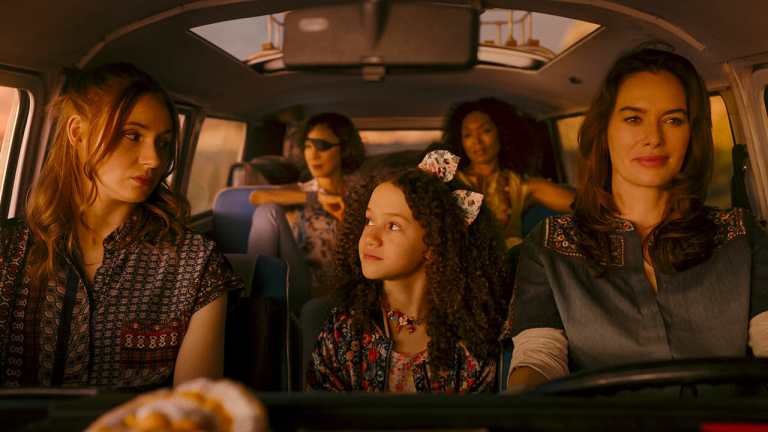The Queerness of Gunpowder Milkshake
We talked to Lena Headey and director Navot Papushado about the queer dynamics at the heart of Netflix's Gunpowder Milkshake.

This article contains spoilers for Gunpowder Milkshake.
Gunpowder Milkshake has many strong qualities, but the movie’s character work isn’t one of them. The Netflix film is visually vibrant featuring crisp and clever fight sequences, but drops the ball when it comes to story, forgetting to make a case for why we should care about the group of woman assassins at its center. It’s a shame because the film brings together an incredible cast of women—including Karen Gillan, Lena Headey, Angela Bassett, Michelle Yeoh, and Carla Gugino—to play the queer found family ostensibly at the heart of this story. Gunpowder Milkshake‘s inability to commit to its fun “be gay, do crimes” vibes is one of the film’s biggest missed opportunities. Let’s discuss…
To call the queerness in Gunpowder Milkshake “subtext” would probably be inaccurate, but the neo-noir never chooses to make its queerness explicit either. Instead, it only heavily implies that Headey’s Scarlet and Bassett’s Anna May may have been “more than friends.” When Scarlet and daughter Sam (Gillan) discuss The Librarians, they single Anna May out by name repeatedly, implying that their connection to her in particular is distinct: “[Anna May] and the other aunts took us in,” Scarlet recounts to Sam. “Best years of my life,” they both agree. Later, when Scarlet returns after 15 years away, it is Anna May who is particularly angry at the betrayal, and whom Scarlet singles out for her (honestly pretty bad) apology. In the denouement’s funeral sequence, Anna May and Scarlet hold hands.
Headey says she and Bassett did discuss the nature of Scarlet and Anna May’s relationship while filming, and they filmed an “embrace” that didn’t make it into the film cut. “We were like, ‘Anna May and Scarlet definitely had a relationship and Scarlet disappeared from people’s lives and everyone’s a little bit pissed at her,'” Headey says of the performances behind the on-screen dynamic. “[We thought] there should be some tension between these two that can read as kind of, two sort of slightly scarred lovers.”
Elsewhere in the The Library, Yeoh’s Florence and Gugino’s Madeleine have even more intimate tension, mostly expressed in a beautiful shot that sees Florence leaning towards Madeleine as if to kiss her. The shot is initially out of focus and from an angle that tricks the viewer into thinking the two will lock lips, only to eventually reveal that Florence is actually moving to whisper something into Madeleine’s ear.
“There are deeper, more valuable connections that we wanted to portray in a very, very subtle way,” says Gunpowder Milkshake director and co-scriptwriter Navot Papushado when asked if he meant to imply queerness with this subtext. “We wanted to create this rich history between the characters, the moment you see them, you understand it goes deeper and longer and that there are emotions that have been bottled up for so many years.”
Papushado says there is “definitely something” between both Anna May and Scarlet and Florence and Madeleine and it wasn’t something the film’s creators wanted to avoid. “On the contrary,” continues Papushado. “I think it’s about them, it’s about these women and their chemistry together. I think only Michelle and Carla [and I] know what Florence is whispering to Madeleine [in that moment]. The producers wanted me to tell them, [but] no one [else] knows.”
For Papushado, not knowing what Florence whispers to Madeleine in that moments has a “bigger impact” than if the audience could hear the words exchanged.
“I hope that it would make the audience like, ‘Oh, I read through that,’ and go a little bit to the backstories, which was talked about,” says Papushado. “I don’t think you can hide, the way it was shot. It is what it is. It’s front and center. I think it one of the only times we used really short lenses, get those intimacy, because most of the movie was shot in wide lenses and those moments were definitely important to achieve.”
While I would argue that the lack of specificity in all of the film’s relationships makes for a poorer story, this leaving of the audience to fill in their own backstories for the characters is not specific to the film’s potentially queer dynamics. By and large, Gunpowder Milkshake is uninterested in the emotional logic of its world, prioritizing aesthetic style above all else. That being said, Hollywood has a long and frustrating history of queercoding and depicting queerness solely through subtext that American film and TV has only begun to grow out of in the last decade. Leaving the viewer to construct much of the emotional specificity of Scarlet and Sam’s mother/daughter relationship is not the same thing as leaving the viewer to construct much of the emotional specificity of the queer-coded Florence and Madeleine, for example.
While Sam, Scarlet, and the Librarians lose Madeleine in the movie’s climactic gunfight, the rest of them survive and are together. In what is arguably the film’s queerest moment, we see the group driving into the sunset together, with Emily (Chloe Coleman), the kid they have more or less adopted. There may be queerness to be found specifically in Scarlet and Anna May’s seemingly on-the-mend relationship, but regardless of how if two characters relate to one another romantically, there is love to be found in this family that exists outside of the traditional heteronormative, nuclear family model. This is an intergenerational family of aunts, parents, friends, maybe-lovers, and a kid, some of whom are biologically related and some of whom are not. They have chosen one another and this non-traditional life, and, for a movie that fails to make its queerness explicit, it’s an unexpectedly happily queer ending for our assassin family.
